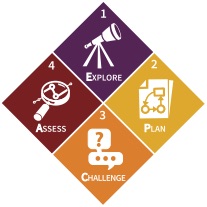Evaluation and assessment of risk is a key part of designing and conducting an experimental protocol. Not only does a thorough risk assessment allow researchers to systematically identify and control hazards, but it also improves the quality of science through more thorough planning, a better understanding of the variables, and by sparking creative and innovative thinking. It allows one to implement tighter controls which reduces uncertainty and increases the safety and quality of your results/product. Failure to consider risk and hazards from the beginning of experimental design can produce delays, roadblocks, and frustration later in the process.
The Risk Assessment process is broken down into four steps and helps to spark creative and innovative thinking.

1) Explore:
Determine the scope of your work, beginning with research objective. What question(s) are you trying to answer? Conduct a broad review of the literature. Speak with others who have done similar work. Are the risks different for different approaches?
2) Plan:
Outline your procedure/tasks. This may include a deeper dive into specific topics in the literature. Determine hazards associated with each step, and control measures for reducing risk. EH&S can help with more detailed guidance on how to handle certain hazards.
3) Challenge:
What assumptions did you use? Question the importance of each step. Seek advice from others. Ask yourself “what could go wrong?”. Have I missed anything? Consider all possible outcomes, how high is the risk?
4) Assess:
Implement a model, prototype, or trial run. Can you perform a dry run to familiarize yourself with equipment and procedures? Can you test your experimental design at a smaller scale or with a less hazardous material? Determine if any design changes are needed. Run your experiment and monitor how your controls perform. Assess as you go and make changes as needed.
![]() Important Information
Important Information
Risk Assessment
It is important to stop, think and plan before doing as well as assess and iterate as you go. Remember, EH&S is always here to assist.
